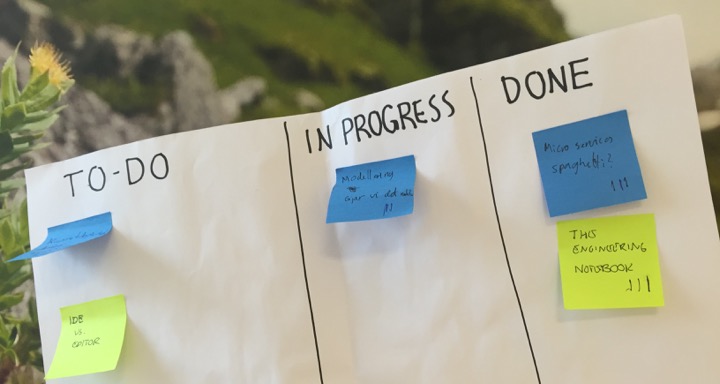Microservices dependency spaghetti, the concept of an engineering notebook, and the importance of software modeling was three main topics discussed at this meeting with Lean Coffee Bergen.

Microservice Spaghetti
The microservice oriented approach is not a new concept in the world of software engineering, and is more traditionally known as service oriented architecture1 - or SOA for short. Such a services should be unassociated, loosely coupled units of functionality that are self-contained.
In reality, however, many of the services had in fact hard dependencies such the ability for inter process communication; programming language and version. Even though they appeared unassociated there ware in fact tightly coupled with one another.
A more modern definition of microservices are web services. They implement the same functionality as their SOA counterpart over standard Internet protocols independent of platforms and programming languages. This allows services to be moved around, switched out, rebuilt, and scaled without having to worry about other their dependents (in theory at last).
The Engineering Notebook
The concept of an Engineering Notebook is the method of to precisely record all work, from concept to prototype - preferably in a notebook by hand. Should software engineers adopt more of this mindset too?
The notebook is always on and it comes with no distracting notifications. You will be able to have one canonical source of history - instead of sifting through multiple git repositories or issue trackers. The notebook also has an infinite amount of different drawings and support for complex notations without installing any special tool or ad-on.
On the other hand, notebooks are not easily searchable and depending on your handwriting may not be easily readable after some amount of time. Some attempts has been made to use digital notebooks (tablets) with handwriting recognition software with varied amount of success.
A notebook can be quite useful for personal planning. Project management tools like JIRA are often better for information sharing than personal task management. Simply making a list in your notebook and crossing them out as you go during the day may be a good solution for keeping track of your day to day activities.
Software Modeling
Many software engineers have a formal understanding of software modeling through UML diagrams2 from their university education and the formal waterfall software development process3. But what role does software modeling play in today’s world of agile software development?
With Agile development there is less design up front, however, this is not an excuse for not making proper models and diagrams of the system(s) in question. This is a good practice that all engineers must restrain and remember to use.
Diagrams are useful for modeling entities and their relations or dependencies. Some diagram can be thrown away when the implementation is done, while others can be kept as reference or documentation for later. Be mindful if the diagram is one or the other.
If you are using JIRA it might be worth to take a look at Gliffy - a digital tool to create and manage flowcharts, wireframes, UML diagrams directly from issues and wiki pages.
Footnotes
Comments
If you have any questions or other feedback to the article, please post them in the comment section bellow and I promise to read them and respond to you on a regular basis.